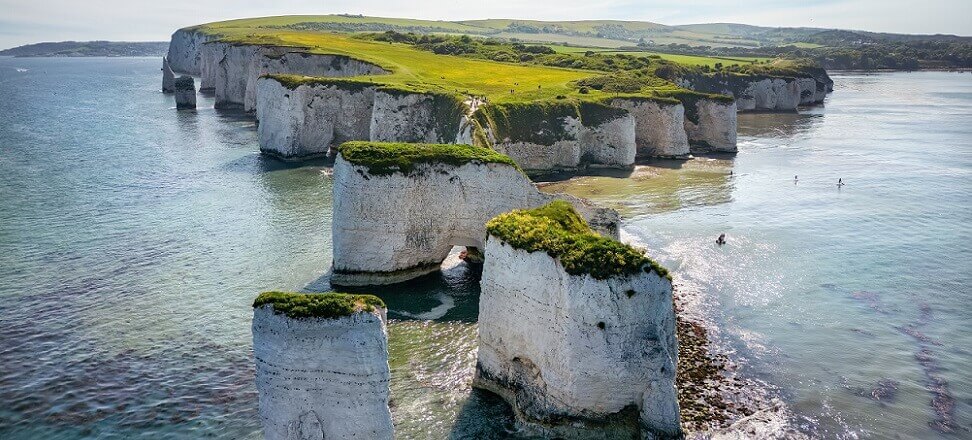At the foot of the coast, various geological formations can be encountered, one of which is sea stacks. These unique creations have been shaped by sea waves and wind for thousands or even millions of years. They are a breeding ground for migratory birds and a challenge for extreme climbing enthusiasts. We zoom in on what sea stacks are and present the ones that are the most spectacular.
Unique works of nature
The rock formations that are the sea stacks have attracted attention for years with their mystery. Formed by water and wind, they are a source of interest to geologists, photographers, climbers and painters. They are formed by the action of erosion, which affects coastal cliffs. Waves and winds hitting them cause separate formations, or just stacks (also called columns or pillars), to emerge from weaker areas of the cliffs over time, usually thousands or even millions of years. They create unique works of nature and can be found on coasts around the world.
The rock columns, rising above the surface of the water, can be of various shapes and sizes. They can be massive, tall, pointed, squat or narrow. Groups of sea stacks can also be formed (such a case is the forms called the Twelve Apostles in Australia). They usually consist of basalt, sandstone, limestone or granite. While on the surface they may appear extremely durable, in reality they are constantly being damaged by the forces of nature. Columns are more prone to collapse every year.
Sea stacks are often important breeding grounds for seabirds. Many migratory birds use them for nests and shelters. They appreciate the isolation and relative safety that these rock formations provide. Many sea stacks are climbing sites. However, they are usually either carefully protected or difficult to access and cannot be climbed.
The world’s most spectacular sea stacks
We present a list of the 10 most spectacular sea stacks in the world:
Old Harry Rocks (UK)
These are the three easternmost of the famous Jurassic Coast chalk formations, which are listed as a UNESCO World Heritage Site. They are located at Handfast Point, on the Isle of Purbeck in Dorset. The name Old Harry Rocks (Old Harry) actually refers to a single stack of chalk. “Old Harry” is also a nickname for the devil, so some people believe it is named after him. By 1896. there was another pile, known as “Old Harry’s Wife,” but erosion caused it to collapse into the sea, leaving only a stump. On the coast, you can rent kayaks or take a boat trip and admire the chalk cliffs from a completely different perspective.
Lange Anna (Germany, Helgoland)
It is a marine pile of mottled sandstone 47 meters high. It is the most distinctive symbol of Heligoland. “Long Anna” is today a natural monument, and the huge biodiversity makes it a nature lover’s paradise. It is also called the “bird rock” for good reason – among others, their breeding grounds are established there. Phulmars and Rattlesnakes, whose colonies number in the thousands. Experts report that there is a serious danger of collapse of the upper 2/3 of the rock formation due to the unstable sand layer located 16 meters above sea level, in the thinnest part of Lange Anna.
Kicker Rock (Galapagos Archipelago)
It is a monument measuring more than 150 meters. It is the remnant of a volcano that, after years of erosion and external influences, took its current form. It is also called Leon Dormido because it resembles the silhouette of a sleeping lion. The pile is part of the Galapagos National Park and is a refuge for blue-footed and frigate birds, as well as an attractive spot for scuba diving enthusiasts.
Ko Tapu (Thailand)
Along with the island of Khao Phing Kan, they are unofficially known as James Bond Island. It is a limestone sea stack that is 20 meters high. Its lower part has been damaged by the sea and weather conditions and is much narrower than the upper part. For this reason, from a distance Ko Tapu resembles a large nail (hence its name – “tapu” in Thai means nail). Tourists can kayak around the bay, exploring Phang Nga Island’s grottoes, mangrove thickets and secluded beaches, while passing extremely beautiful karst formations.
Old Man of Hoy (UK)
It is one of the tallest naval columns in the UK. This red sandstone formation, set on a plinth of magmatic basalt, is 137 meters high and less than 400 years old. Originally it was an arch with two “legs,” which in 1814. In his sketch, he captured William Daniell. In the early 19th century. The storm washed away one of the “legs,” leaving the pile as we know it today. An interesting fact is that a guest book, sealed in a container and buried in a mound at the summit, awaits climbers.
Twelve Apostles (Australia)
It is a formation of limestone columns and a very picturesque natural attraction. The sea stack complex is located near the shore of Port Campbell National Park, forming an iconic part of the Great Ocean Road in the state of Victoria. The stack was originally called “Sow and piglets.” However, it was decided that such majestic rocks must be called something else. Henceforth the formation is called the Twelve Apostles, although the number of columns is smaller. After one collapsed, only eight of them remained, but the proud name remained, perfectly matching the monumentality of this Australian rock formation, by the way.
Totem Pole (Tasmania)
The rock columns are not only a striking landscape feature that attracts tourists and is a challenge for climbing enthusiasts. Totem Pole Column is located within the Tasmanian National Park. It is 65 meters high and was first climbed by John Ewbank and Adam Keller in 1968. Totem Pole owes its name to its tall and slender shape, resembling a totem pole.
The Needles (UK)
These are three chalk columns rising 30 meters above sea level at their highest point. They are standing near the Isle of Wight. Their signature feature is a lighthouse built in 1859. and performing its function to this day. The formation owes its name to the biblical parable of Lot’s wife being turned into a pillar of salt. Sea stacks are very popular with tourists, for whom sea tours are organized from Alum Bay. The rocky trio also had their military episodes. Since the 19th century. through 1954. There was an artillery battery there, and a second life was given to it by the current monarch of Great Britain, making Needles Old Battery a museum and tourist site.
Haystack Rock (Oregon, USA)
Located near Cannon Beach in the US state of Oregon, the Haystack Rock formation is a landmark of the local area. It not only looks dignified in photographs, but also performs a useful function for the environment. On its surface there are numerous invertebrate habitats, but its most characteristic inhabitant is the masconur. The rock measures 72 meters and can be reached on foot during low tides. Its unique environment is protected by the HRAP program, and the formation itself is part of the Oregon Islands National Wildlife Refuge.
Flowerpot Island (Canada, Lake Huron)
These are two distinctive rock columns located on the island. They get their name from the form that resembles a flower or flower vase (flowerpot). They were formed as a result of erosion of the island’s shoreline rocks, and obtained their final form through the action of wind and sea. The island itself, on which the two limestone columns are located, is extremely interesting geologically – it abounds in numerous caves, gorges and chasms, making the almost twin-like columns the perfect crowning touch to this topographically unusual land.

 Polski
Polski






